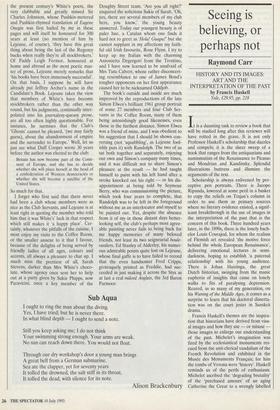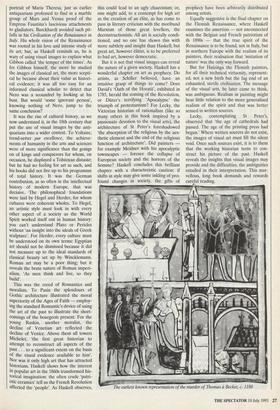Seeing is believing, or perhaps not
Raymond Carr
HISTORY AND ITS IMAGES: ART AND THE INTERPRETATION OF THE PAST by Francis Haskell Yale, £29.95, pp. 218 It is a daunting task to review a book that will be studied long after this reviewer will have rotted in the grave. It is not only Professor Haskell's scholarship that dazzles and compels; it is the sheer sweep of a book that ranges from the antiquarians and numismatists of the Renaissance to Picasso and Mondrian and Kandinsky. Splendid illustrations buttress and illumine the arguments of the text.
Scholarship is always enlivened by per- ceptive pen portraits. There is Jacopo Ripanda, lowered at some peril in a basket to copy the reliefs on Trajan's column in order to use them as primary sources where no literary evidence existed, a signif- icant breakthrough in the use of images in the interpretation of the past that is the concern of this book. Three hundred years later, in the 1890s, there is the lonely bach- elor Louis Courajod, for whom the realism of Flemish art revealed 'the motive force behind the whole European Renaissance', delivering emotional lectures in semi- darkness, hoping to establish 'a paternal relationship' with his young audience. There is Johan Huizinga, the great Dutch historian, swinging from the manic euphoria of insights that came on lonely walks to fits of paralysing depression. Reared, as so many of my generation, on his Waning of the Middle Ages, it comes as a surprise to learn that his doctoral disserta- tion was on the court jester in Sanskrit drama.
Francis Haskell's themes are the inspira- tion that historians have derived from visu- al images and how they use — or misuse those images to enlarge our understanding of the past. Michelet's imagination was fired by the ecclesiastical monuments res- cued from the anti-clerical vandalism of the French Revolution and exhibited in the Musee des Monuments Francais; for him the tombs of Verona were 'history'. Haskell reminds us of the perils of enthusiasm. Michelet ascribed the 'degrading brutality' of the 'purchased amours' of an aging Catherine the Great to a wrongly labelled portrait of Maria Theresa, just as earlier antiquarians professed to find in a marble group of Mars and Venus proof of the Empress Faustina's lascivious attachments to gladiators. Burckhardt avoided such pit- falls in his Civilization of the Renaissance in Italy. His whole vision of the Renaissance was rooted in his love and intense study of its art; but, as Haskell reminds us, he is wary of using visual images to explain what Gibbon called 'the temper of the times'. As for Gibbon himself, the more he studied the images of classical art, the more scepti- cal he became about their value as histori- cal evidence; it was all too easy for an informed classical scholar to detect that Nero was a scoundrel by looking at his bust. But would 'some ignorant person', knowing nothing of Nero, jump to the same conclusion?
It was the rise of cultural history, as we now understand it, in the 18th century that put the use of visual images by the anti- quarians into a wider context. To Voltaire, trend-setter par excellence, the achieve- ments of humanity in the arts and sciences were of more significance than the goings on of kings and conquerors for whom, on occasion, he displayed a Tolstoyan distaste; but he had no feeling for art as such, and his books did not live up to his programme of total history. It was the German contribution, as so often in the intellectual history of modern Europe, that was decisive. The philosophical foundations were laid by Hegel and Herder, for whom cultures were coherent wholes. To Hegel, an artistic style must look in with every other aspect of a society as the World Spirit worked itself out in human history: you can't understand Plato or Pericles without 'an insight into the ideals of Greek sculpture'. For Herder, every culture must be understood on its own terms: Egyptian art should not be dismissed because it did not measure up to the ideal standards of classical beauty set up by Wincklemann. Roman art may be a poor thing; but it reveals the brute nature of Roman imperi- alism. 'As men think and live, so they build'.
This was the creed of Romantics and moralists. To Pasin the splendours of Gothic architecture illustrated the moral superiority of the Ages of Faith — employ- ing the standard Romantic's device of using the art of the past to illustrate the short- comings of the bourgeois present. For the young Ruskin, another moralist, the decline of Venetian art reflected the decline of Venice. Above them all towers Michelet, 'the first great historian to attempt to reconstruct all aspects of the past . . . to a significant extent on the basis of the visual evidence available to him'. Nor was it only high art that has attracted historians. Haskell shows how the interest in popular art in the 1860s transformed his- torical imagination: the often crude 'patri- otic ceramics' tell us the French Revolution affected the 'people'. As Haskell observes, this could lead to an ugly chauvinism; or, one might add, to a contempt for high art as the creation of an elite, as has come to pass in literary criticism with the moribund Marxism of those great levellers, the deconstructionists. All art is socially condi- tioned, and no one has shown this with more subtlety and insight than Haskell; but great art, however elitist, is to be preferred to bad art, however democratic.
But it is not that visual images can reveal the nature of a given society. Haskell has a wonderful chapter on art as prophecy. Do artists, as Schiller believed, have an intuitive grasp of things to come? Does David's 'Oath of the Horatii', exhibited in 1785, herald the coming of the Revolution, or Diirer's terrifying 'Apocalypse' the triumph of protestantism? For Lecky, the Victorian historian of rationalism (like so many others in this book inspired by a passionate devotion to the visual arts), the architecture of St Peter's foreshadowed `the absorption of the religious by the aes- thetic element and the end of the religious function of architecture'. Did painters for example Meidner with his apocalyptic townscapes — foresee the collapse of European society and the horrors of the Somme? Haskell concludes this brilliant chapter with a characteristic caution: if shifts in style may give some inkling of pro- found changes in society, the gifts of prophecy have been arbitrarily distributed among artists.
Equally suggestive is the final chapter on the Flemish Renaissance, where Haskell examines the assertion — not unconnected with the Belgian and French patriotism of th 1890s — that the true spirit of the Renaissance is to be found, not in Italy, but in northern Europe with the realism of its painters, their realisation that 'imitation of nature' was the only way forward.
But for Huizinga the Flemish painters, for all their technical virtuosity, represent- ed, not a new birth but the fag end of an exhausted, sterile civilisation. The message of the visual arts, he later came to think, was ambiguous. Realism in painting might bear little relation to the more generalised realism of the spirit and that was better sensed in written sources.
Lecky, contemplating St Peter's, observed that 'the age of cathedrals had passed. The age of the printing press had begun.' Where written sources do not exist, the images of visual art must fill the silent void. Once such sources exist, it is to them that the working historian turns to con- struct his picture of the past. Haskell reveals the insights that visual images may provide and the difficulties, the ambiguities entailed in their interpretation. This mar- vellous, long book demands and rewards careful reading.
earliest known representation of the murder of Thomas a Becket, c. 1180



















































 Previous page
Previous page